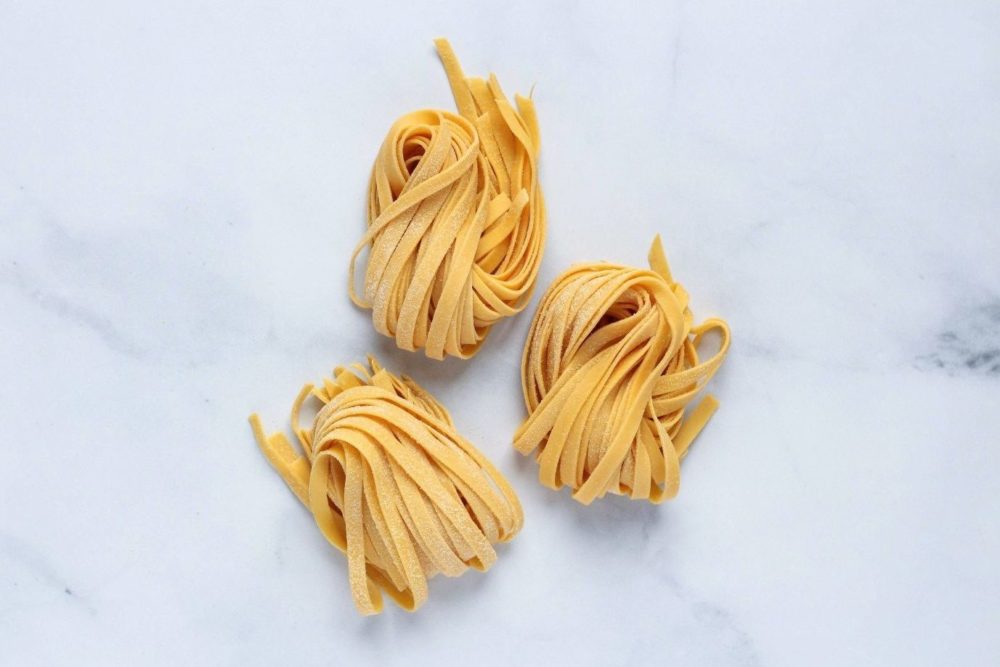
Fresh Egg Pasta
|
|
Time to read 4 min
|
|
Time to read 4 min
Silky, rich, and golden yellow in color, fresh egg pasta is nothing short of pure decadence. Although the ingredient list is short and simple (mainly flour and eggs) getting the technique down takes a bit of practice. So, roll up your sleeves and let’s get to it!
A few important things to note before you get started.
Not all pasta is made the same – literally! Before you dive in, make sure you read this entire post, including the notes so you’re familiar with certain nuances.
Choose a large, clean work surface that’s sturdy, like a countertop or tabletop. We personally like to place a wooden pastry board on top of a countertop or kitchen table. Having a wooden surface gives the dough a porous texture and keeps it “warm” unlike marble or granite. There’s also the added benefit of having a dedicated pasta surface – this keeps your pasta from picking up any unwanted odors from other uses.
Make sure all ingredients are at room temperature. We recommend measuring out your ingredients using an electronic kitchen scale. Note: In Italy, Italian grandmothers rarely measure the ingredients when making pasta because they just know how it should feel (trust us – just try asking one of them for a recipe!). Still, we find that as a beginner, measuring feels safer. The more you make fresh pasta at home, the more you’ll get familiar with how the dough should feel, and the less you’ll have to rely on exact measurements. Note that pasta dough is not always an exact science – the moisture in the dough can vary based on the weather, the humidity in your kitchen, the flour you’re using. As you keep practicing, you’ll be able to feel out the adjustments!
Here at q.b. cucina, we make a point to seek out Italian Type 00 Flour * (we especially like Molino Grassi), but if you’ve only got trusty All Purpose on hand, don’t worry! 00 Flour is more finely milled than American AP, which helps create that delicate texture we love about fresh egg pasta, but you can still use All Purpose in a pinch. Curious to learn more about Italian flour? Flag this Italian flour guide for a deeper dive.
There’s a lot of debate out there on whether or not you should use whole eggs or egg yolks in your pasta dough. Egg yolks add richness and give the dough a bright color. On the other hand, egg whites (which are 90% water) make the dough more pliable and easier to knead, stretch, and shape. In our opinion, a mixture of both egg yolks and whole eggs makes the perfect dough, but you’re welcome to use all whole eggs if you don’t want to waste the whites. Or you can go for an all-yolk dough—this makes an extra rich dough, just know that it will be a little tougher to manipulate!

20 minutes, plus 30 minutes resting
0 minutes
4
360 grams 00 flour (about 2 cups)
190 grams fresh, whole eggs (about 3-4 whole eggs)
5 grams kosher salt
On a large, clean work surface or wooden pastry board, add the flour, forming a mound. In the middle of the mound, use your fingertips to carve out a well, leaving some flour on the bottom of the well.
In a separate bowl, mix together eggs and salt (if using) to form a “wet mixture.” Slowly and gradually, pour the wet mixture into your flour well, being careful not to let it spill over. (If it does spill over, fear not! Simply scoop it up as quickly as you can and reform the wall of the well.) Using a fork, gently start to whisk the flour into the eggs. Again, be careful not to break the wall! The dough will start to come together and form a thick, gooey paste. Continue working in all the flour until the dough starts to become a solid mass.
Scrape up any bits of dough from your surface (we like to use a pastry scraper for this) and start to knead them into your dough ball with your hands. At this point, you can begin kneading the dough by hand.
The dough will feel dry at first, but as you continue to knead the dough, you’ll notice that it starts to hydrate itself as the flour and the eggs are fully incorporated into one another.
If it continues to feel dry as you are kneading it, use a spray bottle filled with room temperature water to spritz the dough a couple of times. Knead the dough for about 10 minutes. To knead, simply press the heel of your hand into the dough, press down, and release. Rotate the dough ¼ of the way around and repeat. Continue in this way until the dough is smooth and silky, about 10-15 minutes.
Note: You can’t over-knead fresh egg pasta dough, but you can under-knead it. It’s important to knead the dough fully, at least 10-15 minutes to help it really hydrate.
Finally, cover the dough in plastic wrap and let it rest at room temperature for at least 30 minutes and up to 2 hours. If saving for later, place it in the fridge, wrapped tightly, and use within 24 hours.
Use the dough to roll out your preferred pasta shape.